36 CFR Part 1190, Proposed Accessibility Guidelines for Pedestrian Facilities in the Public Right-of-Way: Notice of Proposed Rulemaking (NPRM)
R304 Curb Ramps and Blended Transitions
R304.1 General. Curb ramps and blended transitions shall comply with R304.
Advisory R304.1 General. There are two types of curb ramps:
• Perpendicular curb ramps have a running slope that cuts through or is built up to the curb at right angles or meets the gutter break at right angles where the curb is curved. On large corner radiuses, it will be necessary to indent the gutter break on one side of the curb ramp in order for the curb ramp to meet the gutter break at right angles.
• Parallel curb ramps have a running slope that is in-line with the direction of sidewalk travel and lower the sidewalk to a level turning space where a turn is made to enter the pedestrian street crossing.
Advisory R304.1 General (continued). Perpendicular curb ramps can be provided where the sidewalk is at least 3.7 m (12.0 ft) wide. Parallel curb ramps can be provided where the sidewalk is at least 1.2 m (4.0 ft) wide. Parallel and perpendicular curb ramps can be combined. A parallel curb ramp is used to lower the sidewalk to a mid-landing and a short perpendicular curb ramp connects the landing to the street. Combination curb ramps can be provided where the sidewalk is at least 1.8 m (6.0 ft) wide. Blended transitions are raised pedestrian street crossings, depressed corners, or similar connections between pedestrian access routes at the level of the sidewalk and the level of the pedestrian street crossing that have a grade of 5 percent or less. Blended transitions are suitable for a range of sidewalk conditions.
R304.2 Perpendicular Curb Ramps. Perpendicular curb ramps shall comply with R304.2 and R304.5.
R304.2.1 Turning Space. A turning space 1.2 m (4.0 ft) minimum by 1.2 m (4.0 ft) minimum shall be provided at the top of the curb ramp and shall be permitted to overlap other turning spaces and clear spaces. Where the turning space is constrained at the back-of-sidewalk, the turning space shall be 1.2 m (4.0 ft) minimum by 1.5 m (5.0 ft) minimum. The 1.5 m (5.0 ft) dimension shall be provided in the direction of the ramp run.
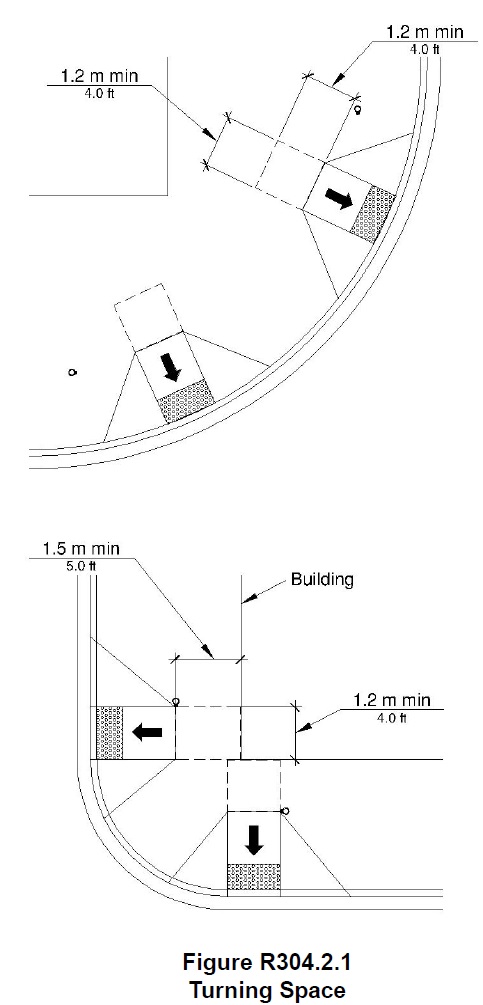
R304.2.2 Running Slope. The running slope of the curb ramp shall cut through or shall be built up to the curb at right angles or shall meet the gutter grade break at right angles where the curb is curved. The running slope of the curb ramp shall be 5 percent minimum and 8.3 percent maximum but shall not require the ramp length to exceed 4.5 m (15.0 ft). The running slope of the turning space shall be 2 percent maximum.
R304.2.3 Flared Sides. Where a pedestrian circulation path crosses the curb ramp, flared sides shall be sloped 10 percent maximum, measured parallel to the curb line.
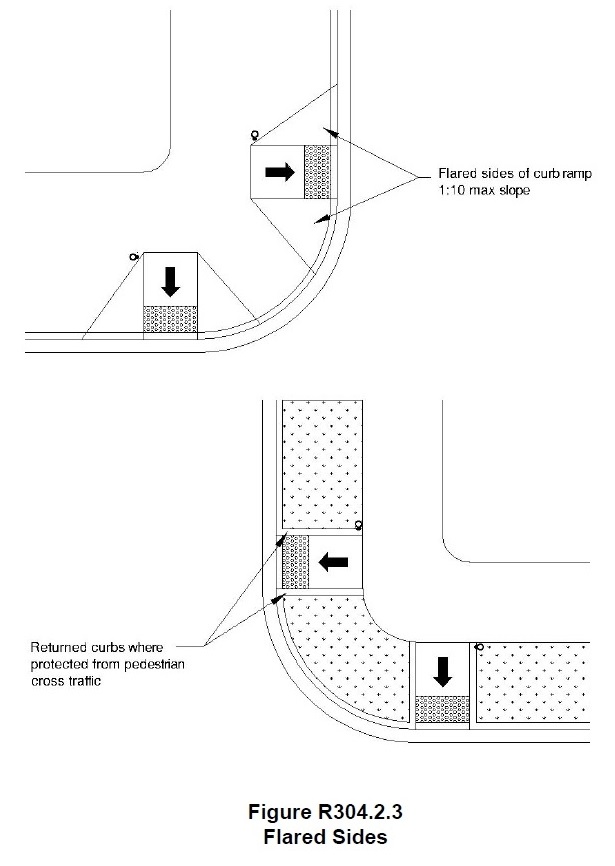
R304.3 Parallel Curb Ramps. Parallel curb ramps shall comply with R304.3 and R304.5.
R304.3.1 Turning Space. A turning space 1.2 m (4.0 ft) minimum by 1.2 m (4.0 ft) minimum shall be provided at the bottom of the curb ramp and shall be permitted to overlap other turning spaces and clear spaces. If the turning space is constrained on 2 or more sides, the turning space shall be 1.2 m (4.0 ft) minimum by 1.5 m (5.0 ft). The 1.5 m (5.0 ft) dimension shall be provided in the direction of the pedestrian street crossing.
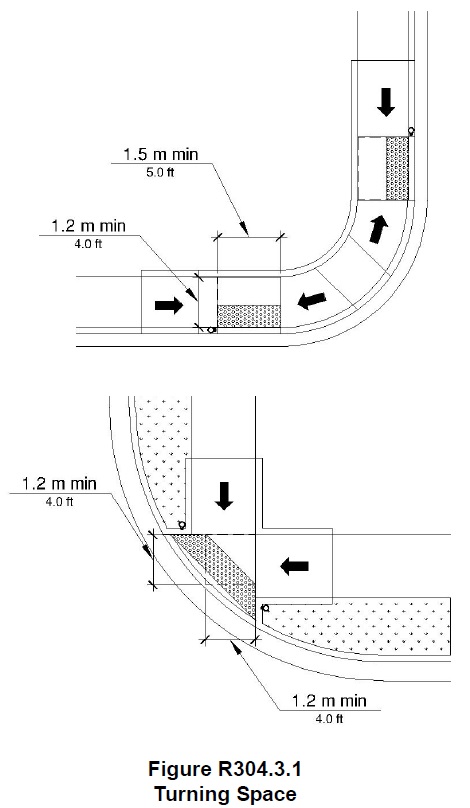
R304.3.2 Running Slope. The running slope of the curb ramp shall be in-line with the direction of sidewalk travel. The running slope of the curb ramp shall be 5 percent minimum and 8.3 percent maximum but shall not require the ramp length to exceed 4.5 m (15.0 ft) minimum. The running slope of the turning space shall be 2 percent maximum.
R304.4 Blended Transitions. Blended transitions shall comply with R304.4 and R304.5.
R304.4.1 Running Slope. The running slope of blended transitions shall be 5 percent maximum.
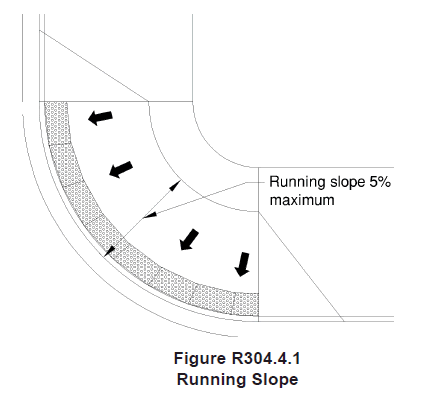
R304.5 Common Requirements. Curb ramps and blended transitions shall comply with R304.5.
R304.5.1 Width. The clear width of curb ramp runs (excluding any flared sides), blended transitions, and turning spaces shall be 1.2 m (4.0 ft) minimum.
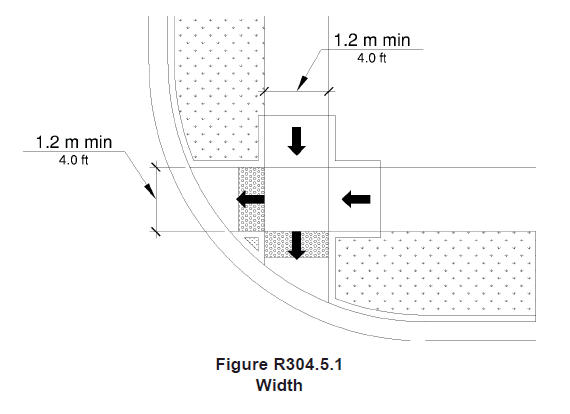
R304.5.2 Grade Breaks. Grade breaks at the top and bottom of curb ramp runs shall be perpendicular to the direction of the ramp run. Grade breaks shall not be permitted on the surface of ramp runs and turning spaces. Surface slopes that meet at grade breaks shall be flush.
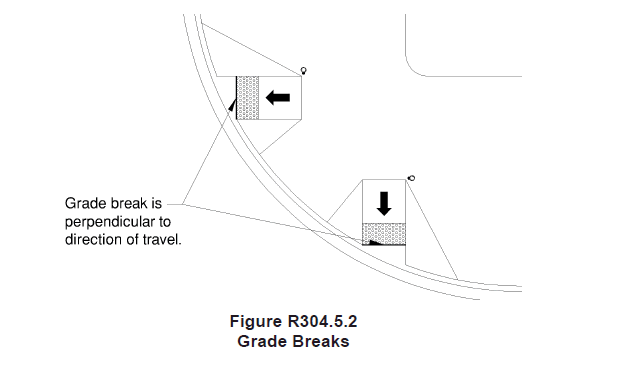
R304.5.3 Cross Slope. The cross slope of curb ramps, blended transitions, and turning spaces shall be 2 percent maximum. At pedestrian street crossings without yield or stop control and at midblock pedestrian street crossings, the cross slope shall be permitted to equal the street or highway grade.
R304.5.4 Counter Slope. The counter slope of the gutter or street at the foot of curb ramp runs, blended transitions, and turning spaces shall be 5 percent maximum.
R304.5.5 Clear Space. Beyond the bottom grade break, a clear space 1.2 m (4.0 ft) minimum by 1.2 m (4.0 ft) minimum shall be provided within the width of the pedestrian street crossing and wholly outside the parallel vehicle travel lane.
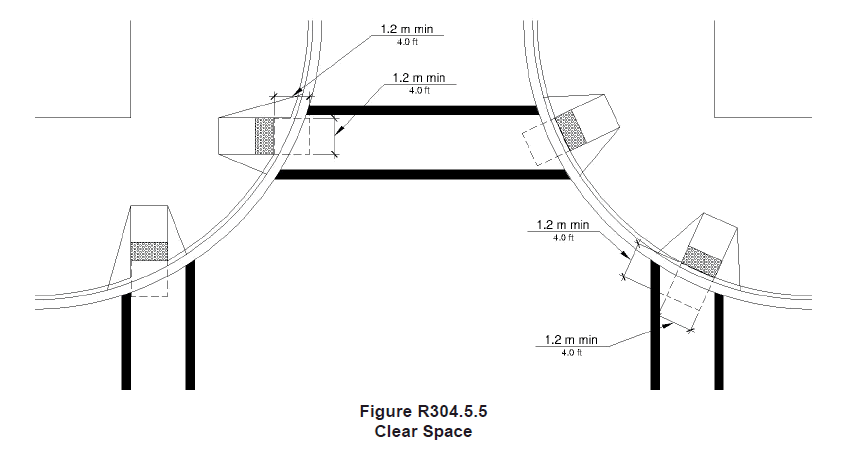

User Comments/Questions
Add Comment/Question